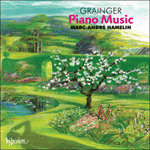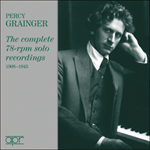It was during Grainger’s London years that he came into contact with many artists, composers and musicians who were all to play some part in formulating his career as pianist and furthering his subsequent recognition as a composer. His numerous appearances in ‘at homes’ quickly established him in London society, and it was at such a gathering that he met the Irish composer Sir Charles Villiers Stanford (1852–1924), who later hosted at least four similar functions at which Grainger performed. From 1904 onwards their friendship grew apace and they were to work closely with each other until Grainger’s departure for America in 1914. The
Four Irish Dances had been transcribed from Stanford’s orchestral versions, Op 79, during the early years of their professional association, and Grainger would often include them in his solo recitals along with Stanford’s own
Three Rhapsodies Op 92, written specially for him in the summer of 1904. The music of these dances is based on traditional Irish folk tunes which Stanford selected from his own edition of
The Complete Petrie Collection of Ancient Irish Music. The first dance,
A March-Jig (Maguire’s Kick) is based on two melodies, the main tune, ‘Maguire’s Kick’, being combined with a jig from County Leitrim. Irish rebels had used the primary tune as a marching air in 1798. The entire thematic material for
A Slow Dance is taken from a long and varied tune named ‘Madame Cole’, described as ‘one of Carolan’s finest airs’. It was composed by the blind Irish harper Turlough O’Carolan (1670–1738) for the marriage in 1719 of John Cole of Florence Court, County Fermanagh, to Jane Saunderson of County Cavanagh. Grainger points out that this tune is more redolent of the art music of the seventeenth century than of the Irish countryside. In some parts of Ireland, country folk still believe in the existence of leprechauns, tiny fairies who wear tall hats and knee-breeches.
The Leprechaun’s Dance is a delicate movement consisting of two tunes in 9/8 time, a ‘Jig’ and a ‘Hop Jig’. The final number of the set,
A Reel, opens and closes with a section based on a rollicking Cork reel engagingly titled ‘Take her out and air her’. This is contrasted with a graceful middle episode built around the winsome melody ‘The cutting of the hay’.
from notes by Barry Peter Ould © 2002
C’est pendant ses années londoniennes que Grainger entre en contact avec de nombreux artistes, compositeurs et musiciens qui tous joueront un rôle dans la formation de sa carrière de pianiste et, plus tard, contribueront à sa réputation de compositeur. Ses nombreuses participations à des concerts privés l’établissent rapidement dans la société londonienne, et c’est lors de l’une de ces réunions mondaines qu’il fait la connaissance de Sir Charles Villiers Stanford (1852–1924), compositeur irlandais qui organisera par la suite chez lui au moins quatre concerts au cours desquels Grainger se produira. À partir de 1904, leur amitié se développe rapidement et ils travaillent étroitement ensemble jusqu’au départ de Grainger pour les États-Unis en 1914. Grainger transcrit les
Four Irish Dances («Quatre danses irlandaises»), op. 79, de Stanford, pour orchestre à l’origine, au cours des premières années de leur association professionnelle et les inclura souvent dans ses récitals en solo, de même que les
Three Rhapsodies («Trois rhapsodies»), op. 92, composées par Stanford à son intention, à l’été 1904. Ces danses sont basées sur des airs traditionnels irlandais, choisis par Stanford dans sa propre édition de
The Complete Petrie Collection of Ancient Irish Music («Anthologie complète de Petrie de musique irlandaise ancienne»). La première danse,
A March-Jig (Maguire’s Kick) repose sur deux mélodies; le thème principal, «Maguire’s Kick», est associé à une jig du comté de Leitrim. Les rebelles irlandais utilisèrent le premier thème comme air de marche en 1798. Tout le matériau thématique de
A Slow Dance («Danse lente») est emprunté à une longue mélodie variée intitulée «Madame Cole», décrite comme «l’un des plus beaux airs de Carolan». Elle a été composée par un harpiste irlandais aveugle, Turlough O’Carolan (1670–1738), à l’occasion du mariage, en 1719, de John Cole of Florence Court (comté de Fermanagh) et de Jane Saunderson (comté de Cavanagh). Grainger souligne que cet air évoque plus la musique savante du XVIIe siècle que les campagnes irlandaises. Dans certaines parties de l’Irlande, les habitants des campagnes croient toujours à l’existence des leprechauns, lutins coiffés de grands chapeaux et de knickers.
The Leprechaun’s Dance («La danse du lutin») est une pièce délicate consistant en deux airs à 9/8, une «Jig» et une «Hop Jig». Le dernier numéro du recueil,
A Reel, débute et se termine par une section basée sur un joyeux reel de Cork, joliment intitulé: «Take her out and air her» («Emmène-la se promener qu’elle prenne l’air»). Il contraste avec un gracieux épisode central bâti autour d’une engageante mélodie, «The cutting of the hay» («Couper les foins»).
extrait des notes rédigées par Barry Peter Ould © 2002
Français: Josée Bégaud
Während seiner Londoner Jahre lernte Grainger viele Künstler, Komponisten und Musiker kennen, die alle in der einen oder anderen Weise dazu beitrugen, dass er eine Pianistenlaufbahn einschlug, und die auch später seine Anerkennung als Komponisten förderten. Mit seinen vielen Auftritte in Privathäusern etablierte er sich schnell in der Londoner Gesellschaft, und eben bei einer solchen Zusammenkunft begegnete er dem irischen Komponisten Sir Charles Villiers Stanford (1852–1924), der später mindestens vier ähnliche Veranstaltungen organisierte, auf denen Grainger spielte. Ab 1904 wuchs ihre Freundschaft stetig, und sie sollten bis Graingers Abreise nach Amerika im Jahre 1914 eng zusammenarbeiten. Die
Four Irish Dances sind Bearbeitungen der Orchesterversionen Stanfords (Op. 79), die Grainger in den ersten Jahren ihrer Zusammenarbeit erstellt hatte, und die er in seinen Klavierabenden oft zusammen mit Stanfords eigenen
Three Rhapsodies, Op. 92, im Sommer 1904 für ihn komponiert hatte, aufführte. Die Tänze basieren auf traditionellen irischen Volksliedern, die Stanford aus seiner eigenen Edition von
The Complete Petrie Collection of Ancient Irish Music ausgewählt hatte. Der erste Tanz,
A March-Jig (Maguire’s Kick), basiert auf zwei Melodien, wobei die Hauptmelodie „Maguire’s Kick“ mit einem Jig aus Leitrim kombiniert ist. Die irischen Rebellen hatten erstere Melodie als Marschlied im Jahre 1798 verwendet. Das gesamte thematische Material aus
A Slow Dance ist einer langen und reichhaltigen Melodie mit dem Titel „Madame Cole“ entnommen, die als „eine der besten Weisen Carolans“ beschrieben wird. Sie war von dem blinden irischen Harfenisten Turlough O’Carolan (1670–1738) anlässlich der Hochzeit von John Cole von Florence Court, Fermanagh, und Jane Saunderson von Cavanagh komponiert worden. Grainger macht darauf aufmerksam, dass diese Melodie eher an die Kunstmusik des 17. Jahrhunderts erinnert als an die irische Landschaft. In einigen Teilen Irlands glauben die Leute auf dem Lande noch an „Leprechauns“, winzige Elfen mit hohen Hüten und Kniehosen.
The Leprechaun’s Dance ist ein anmutiger Satz mit zwei Melodien in einem 9/8 Rhythmus, einem „Jig“ und einem „Hop Jig“. Die letzte Nummer aus dieser Reihe,
A Reel, beginnt und schließt mit einem ausgelassenen Reel aus Cork, der den gewinnenden Titel „Führ’ sie aus bring sie an die frische Luft“ trägt. Dem ist ein eleganter Mittelteil gegenübergestellt, der um die Melodie „Das Heumähen“ herumkonstruiert ist.
aus dem Begleittext von Barry Peter Ould © 2002
Deutsch: Viola Scheffel


 Grainger: Piano Music
Grainger: Piano Music Percy Grainger - The complete 78-rpm solo recordings
Percy Grainger - The complete 78-rpm solo recordings
